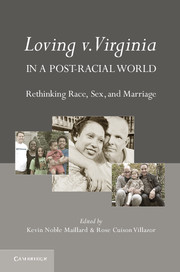Book contents
- Frontmatter
- Contents
- About the Contributors
- Acknowledgments
- Foreword
- Introduction Loving v. Virginia in a Post-Racial World
- Part One Explaining Loving v. Virginia
- Part Two Historical Antecedents to Loving
- 2 Telling Stories of Love, Sex, and Race
- 3 Loving in Indian Territory
- 4 American Mestizo
- 5 Perez v. Sharp and the Limits of Loving
- Part Three Loving and Interracial Relationships: Contemporary Challenges
- Part Four Considering the Limits of Loving
- Part Five Loving Outside the U.S. Borders
- Part Six Loving and Beyond: Marriage, Intimacy, and Diverse Relationships
- Permission Granted
- Index
- References
2 - Telling Stories of Love, Sex, and Race
Published online by Cambridge University Press: 05 July 2012
- Frontmatter
- Contents
- About the Contributors
- Acknowledgments
- Foreword
- Introduction Loving v. Virginia in a Post-Racial World
- Part One Explaining Loving v. Virginia
- Part Two Historical Antecedents to Loving
- 2 Telling Stories of Love, Sex, and Race
- 3 Loving in Indian Territory
- 4 American Mestizo
- 5 Perez v. Sharp and the Limits of Loving
- Part Three Loving and Interracial Relationships: Contemporary Challenges
- Part Four Considering the Limits of Loving
- Part Five Loving Outside the U.S. Borders
- Part Six Loving and Beyond: Marriage, Intimacy, and Diverse Relationships
- Permission Granted
- Index
- References
Summary
In 1662, more than 300 years before Loving v. Virginia, the Virginia colonial legislature enacted the first statute penalizing sex across the color line. In the years that followed, legislators, legal thinkers, and racial ideologues throughout the South condemned the practice, promising banishment, fines, and imprisonment for those who refused to obey. Interracial sex, the guardians of the social order reasoned, blurred the carefully drawn distinctions between black and white, slave and free. Yet few doubted then and no one doubts now that interracial sex, if not a frequent part of Southern life, was not uncommon either. The sheer number of people with light-brown skin and soft, wavy hair – 500,000 in the 1860 census, a number most agree was a gross underestimate – provided glaring evidence of interracial contacts for even those who were not personally involved in the practice.
Yet, notwithstanding their regular occurrence, efforts to provide some content and character to these early relationships are fraught with difficulty. Sources are difficult to locate and sometimes even harder to interpret, leaving many simply to rely on stock characters and familiar storylines. Following the groundbreaking work of scholars like Deborah Gray White, most point out today how interracial sex in the years before Loving was used as a tool of oppression, reinforcing the bedrock principles of white supremacy and patriarchal privilege. Many white men of all social ranks regularly took advantage of black women, and white society in general was all too willing to greet accusations of black-on-white rape with violence and destruction.
- Type
- Chapter
- Information
- Loving v. Virginia in a Post-Racial WorldRethinking Race, Sex, and Marriage, pp. 29 - 45Publisher: Cambridge University PressPrint publication year: 2012

